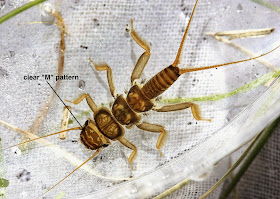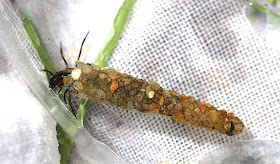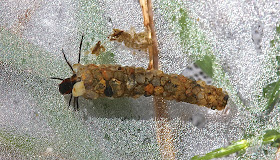For awhile I saw nothing but stoneflies -- Giants and Commons -- at the South River (Greene County) this morning. But then I picked up this little critter which I knew was a small minnow mayfly, so I paused to take photos.
What a beauty! The small minnow mayfly Baetis flavistriga. I've found them before, but I've never seen one with these spectacular colors. Beaty says this one can be found in our streams from April through November ("The Ephemeroptera of North Carolina," p. 6) and that it's "common," but I've actually seen very few. They're small: the range is 4-6 mm. This one was about 4.5 mm; this photo gives a better impression of its actual size.
While we should look at the labial palps to be certain of our ID, there are two physical features that will suffice: 1) there are "two large submedian kidney shaped spots" on the abdominal terga," and the "caudal filaments [have] a medial dark band." (Beaty, p. 6)
I also found a mature Acentrella nadineae, another "hanger-on" from the summer.
But there was also a sign that we're moving into the winter when we see a different set of small minnow mayflies. I found the first Baetis tricaudatus of the season. Note the length of the tails (caudal filaments). With this species the "middle caudal filament [is] less than half as long as [the] lateral filaments." (Beaty, p. 6)
True, at this size -- 3.5 mm -- they're not much to look at. But this is what we'll be seeing in South River in February and March when they'll measure from 5 to 8 mm.
________________
Of caddisflies, I found common netspinners (C. alhedra), fingernets (Dolophilodes), and a number of small freeliving larvae. In this stream, all of the freeliving larvae seem to be Rhyacophila fuscula, the green one with the "topless" H pattern on its head.
But the caddisfly find of the day was this "Saddle-case maker," Glossosoma nigrior.
I have never seen a Glossosomatid make that kind of case. Their cases are invariably "dome-shaped." Obviously this little larva forgot to look at the blueprint! That white pebble on the left side was not a very good choice. As Glossosomatids commonly do, this larva eventually crawled out of its case.
________________
Of course we mustn't leave out all of those stoneflies.
1. Common stonefly, Acroneuria abnormis.
2. Common stonefly, Paragnetina immarginata.
3. Giant stonefly, Pteronarcys proteus.
4. And Giant stonefly, Pteronarcys biloba.
________________
But this one, for me, made the day: small minnow mayfly, Baetis flavistriga.
























































